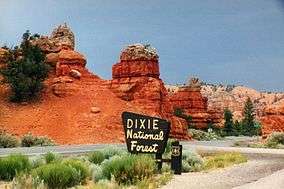Dixie National Forest
| Dixie National Forest | |
|---|---|
|
IUCN category VI (protected area with sustainable use of natural resources) | |
|
Red Canyon at Scenic Byway 12 | |
 | |
| Location | Garfield, Iron, Kane, Piute, Washington, and Wayne counties, Utah, U.S. |
| Nearest city | Cedar City, UT |
| Coordinates | 38°01′00″N 111°38′00″W / 38.016667°N 111.633333°WCoordinates: 38°01′00″N 111°38′00″W / 38.016667°N 111.633333°W |
| Area | 1,889,106 acres (7,644.94 km2)[1] |
| Established | September 25, 1905[2] |
| Visitors | 700,000 (in 2006) |
| Governing body | U.S. Forest Service |
| Website | Dixie National Forest |
Dixie National Forest is a United States National Forest in Utah with headquarters in Cedar City. It occupies almost two million acres (8,000 km²) and stretches for about 170 miles (270 km) across southern Utah. The largest national forest in Utah, it straddles the divide between the Great Basin and the Colorado River. In descending order of forestland area it is located in parts of Garfield, Washington, Iron, Kane, Wayne, and Piute counties. The majority (over 55%) of forest acreage lies in Garfield County. There are local ranger district offices in Cedar City, Escalante, Panguitch, St. George, and Teasdale.[3]
Elevations vary from 2,800 feet (850 m) above sea level near St. George, Utah to 11,322 feet (3,451 m) at Blue Bell Knoll on Boulder Mountain. The southern rim of the Great Basin, near the Colorado River, provides spectacular scenery. Colorado River canyons are made up of multi-colored cliffs and steep-walled gorges.
The Forest is divided into four geographic areas. High altitude forests in gently rolling hills characterize the Markagunt, Paunsaugunt, and Aquarius Plateaus. Boulder Mountain, one of the largest high-elevation plateaus in the United States, is dotted with hundreds of small lakes 10,000 to 11,000 feet (3,000 to 3,400 m) above sea level. The forest includes the Pine Valley Mountains north of St. George
The Forest has many climatic extremes. Precipitation ranges from 10 inches (250 mm) in the lower elevations to more than 40 inches (1,000 mm) per year near Brian Head Peak 11,307 feet (3,446 m). At the higher elevations, most of the annual precipitation falls as snow. Thunderstorms are common during July and August and produce heavy rains. In some areas, August is the wettest month of the year.
Temperature extremes can be impressive, with summer temperatures exceeding 100 degrees Fahrenheit (38 degrees Celsius) near St. George and winter lows exceeding -30 degrees Fahrenheit (-34 degrees Celsius) on the plateau tops.
The vegetation of the Forest grades from sparse, desert-type plants at the lower elevations to stand of low-growing pinyon pine and juniper dominating the mid-elevations. At the higher elevations, aspen and conifers such as pine, spruce, and fir predominate.
The Dixie Forest Reserve was established on September 25, 1905 by the General Land Office. The name was derived from the local description of the warm southern part of Utah as "Dixie".[4] In 1906 the U.S. Forest Service assumed responsibility for the lands, and on March 4, 1907 it became a National Forest. The western part of Sevier National Forest was added on July 1, 1922, and all of Powell National Forest on October 1, 1944.[5]
Wilderness areas
There are four officially designated wilderness areas within Dixie National Forest that are part of the National Wilderness Preservation System.
- Ashdown Gorge Wilderness
- Box-Death Hollow Wilderness
- Cottonwood Forest Wilderness
- Pine Valley Mountain Wilderness
See also
- List of U.S. national forests
- Panguitch Lake
- Bryce Canyon Natural History Association
- List of Utah Wilderness areas
- Podunk
- Paunsaugunt Plateau
References
- ↑ "Land Areas of the National Forest System". U.S. Forest Service. January 2013. Retrieved January 9, 2013.
- ↑ "The National Forests of the United States" (PDF). ForestHistory.org. Retrieved July 30, 2012.
- ↑ USFS Ranger Districts by State
- ↑ "History". Dixie National Forest. U.S. Forest Service. 2008-08-27.
- ↑ Davis, Richard C. (September 29, 2005). "National Forests of the United States" (pdf). The Forest History Society.
External links
| Wikimedia Commons has media related to Dixie National Forest. |
